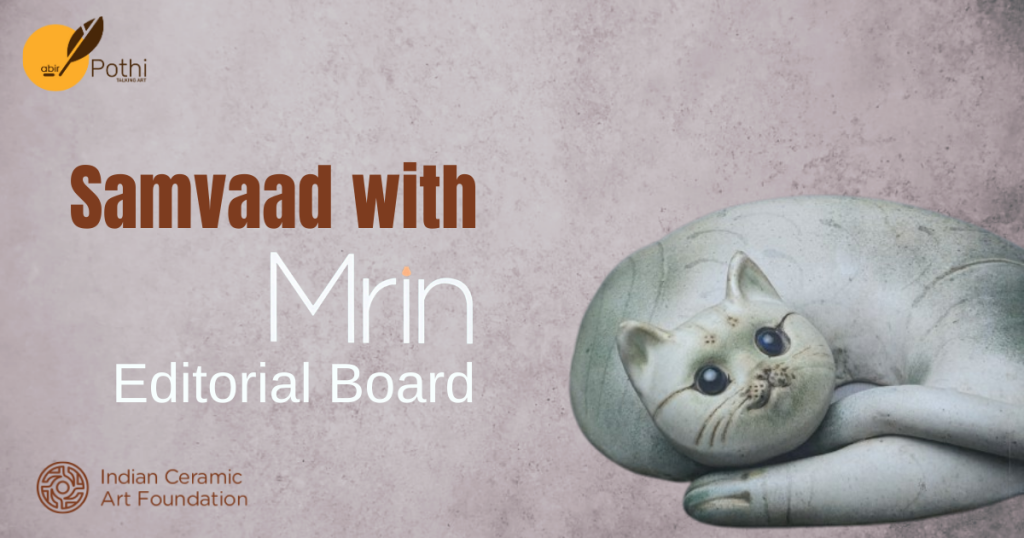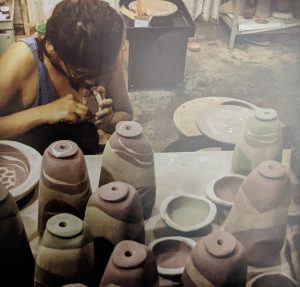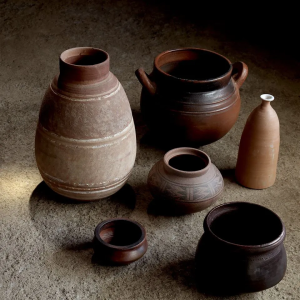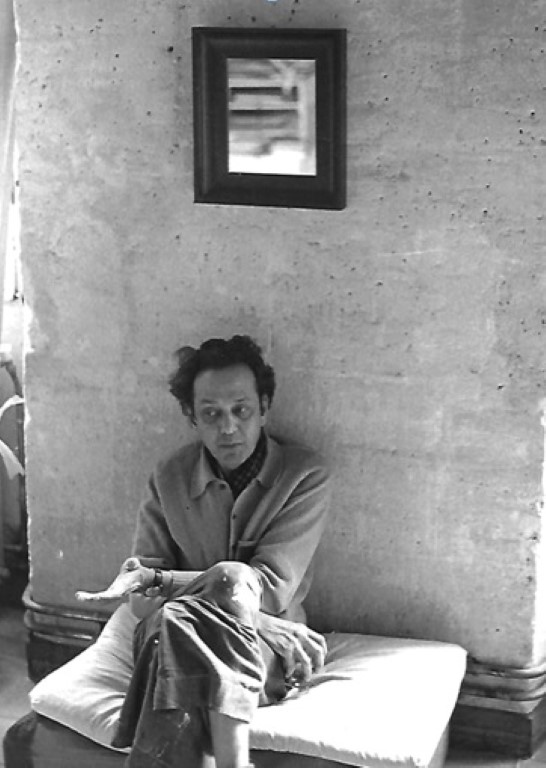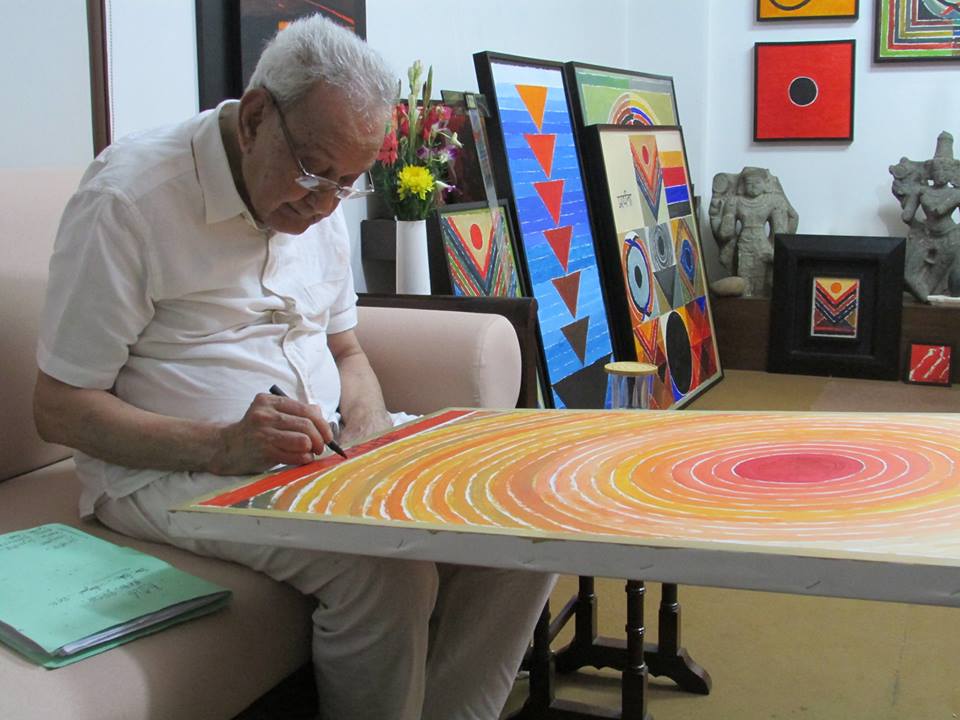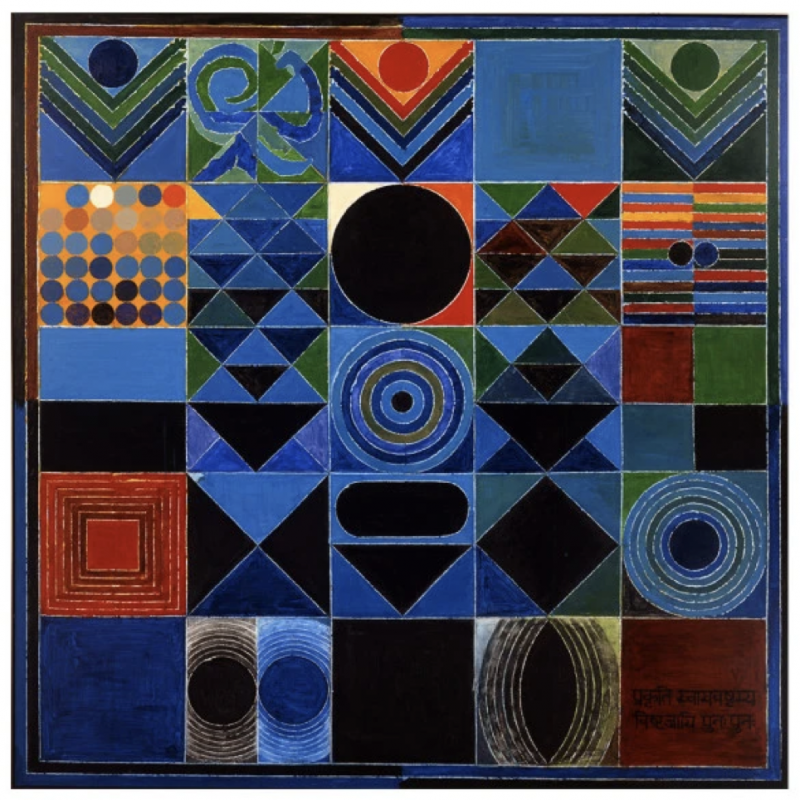To promote Indian ceramic art among the Indian art fraternity and around the world, the Indian Ceramic Art Foundation (ICAF) publishes a journal of Indian ceramic art titled ‘MRIN’. ICAF is the national, non-profit organisation aimed at promoting knowledge, engagement and appreciation of ceramic art through establishing networks among the artist community, educators, designers, collectors, patrons, students, museums, traditional craftsmen and lay people.
In this hour-long interview with Nidheesh Tyagi for Abir Pothi, Shampa Shah, the editor of MRIN, Khanjan Dalal, founding member of MRIN and Kristine Michael, member of the advisory board talk about the MRIN magazine and how it can be a catalyst in improving the current scenario of Indian ceramic art.
This is an English excerpt and you can watch the interview here.
Nidheesh Tyagi: Give a brief glimpse about ICAF.
Khanjan Dalal: Talking about ICAF, it’s a non-profit organisation dedicated to improving and expanding opportunities in Indian ceramic arts and crafts. Basically, we are six founding members that include, Shampa Shah, Falguni Bhatt, Madhur Sen, Sandeep Manchekar, and Vilasini Reddy. Kristine Michael is on our permanent advisory board. We use to organise seminars, symposiums, talks by other artists for our members. We also organize exhibitions, one or two exhibitions a year for our members from all over India and we also started this journal of Ceramic Arts, which is just concentrating on ceramics arts in India. This is the first issue that has come out now. It is going to be biannual, so there will be another issue coming up in the next six months. Christine Michael will be the guest editor for the next issue.
Nidheesh Tyagi: How did this idea come about to have the magazine in printed format?
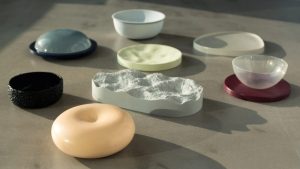
Khanjan Dalal: Look it’s a very unorganized sector at this moment. There’s no interaction, there isn’t much awareness, and there isn’t much of a knowledge sharing platform in India. Whereas in other countries as in the US and England, they have many other institutions and also smaller groups who do this kind of activity on a regular basis. For example, in Australia, ceramics is a very strong and well-organized industry that does a lot of things like exhibitions and so on, but it also has its own magazine. So the idea started that, we should have a record. First of all, the record is the most important thing. How do you record your ceramic history, or let’s say history in making. So many things have happened in past, many pioneer potters are there so many potters in the rural areas. So it’s some kind of documentation, some kind of a research, it’s a source of information not only for the common people, but also people who practice ceramics. That awareness was always lacking. So the journal is going to provide that. It was like a simple idea that OK let’s see if we can do this and it’s not going to be online, it’s going to be a printed magazine because in our country in the rural areas that older generation are not that tech savvy, it is very essential that they can stick to the old tradition of holding the magazine and read it, and that’s how it is going to be for at least a couple of years now. So the journal is about that. And we started out that discussing what to do, how to go about doing this. We are also new. We are not into publishing business. So, those are the challenges that you face while producing a journal like that.
It took us probably 2 years to do this. But we’ve managed somehow to get it out. We faced many challenges, so many co-ordinations was needed to be done between various kinds of agencies and people. I think everybody, myself, Shampa, Phalguni and lots of other people involved into it, have been very patiently and silently working towards getting things done. Now we have a decent idea about how things work in terms of publishing a magazine like that. I’m sure the next issue is going to be quicker and more interesting.
Nidheesh Tyagi: Coming to Shampa as she was the editor of this first edition of this Mrin, What all went in bringing out the magazine as you thought about a print magazine? I remember talking to you long back about it. Why print and why not an online kind of a thing. But then having decided that and then having, thinking about it, you are going to bring a print edition of Mrin. Can you just run us through the whole process of bringing out the 1st edition?
Shampa Shah: There has never been a magazine fully dedicated to ceramics. So this was a new thing. So, the basic thing was to conceptualize, what would be the focus of the magazine. How to structure it? What all would go into it? There aren’t many writers. It’s a comparatively new medium. Actually, it’s one of the most ancient medium, but in the world of art, it’s acceptance among the galleries, among the artist community is still making its way. The most important thing was to think of the writers and the best part with the ICAF is that, here in ICAF all of us are practicing ceramic artist. We are not from the academics. All of us are practicing artists and I think what we decided was to have writers from among us. So, the idea was that the praxis should be the backbone of this magazine also. With that I think we started working on the structure of the entire magazine and we decided to have certain regular columns because ceramics is a medium which has an interface, it shares an interface with a lot of other mediums. Clay has a big role to play in education. How it combines wonderfully with the architecture in more than one ways. Likewise the public spaces also needed to be looked at. That’s how it has been planned.
Nidheesh Tyagi: So it looks like a pretty kind of an act of conviction. I may be wrong, but the kind of a class difference, ceramic artist and the so called regular artists was the reason to come out with a magazine only dedicated to ceramics to have your own voice?
Shampa Shah: Yeah, I mean, it goes without saying, why this question has actually, is in your mind because we do feel that in the past two decades, the kind of strides that this medium has made. It is not getting the kind of attention it actually needs to get nationally and internationally. Somehow the focus tends to be more on painting and sculpture and because in ceramics as part of the curriculum say for example, Baroda has ceramics, but it’s a sub course. It’s not like painting and sculpture, you don’t do it in ceramics actually. So that’s why very few art colleges have ceramics as a separate thing where in you can do your post-graduation. So that is one thing and the very nature of this medium, because it’s such a fragile medium, it took the national art exhibitions long time to include ceramics. And it was much later that ceramic got included into International exhibition.
Nidheesh Tyagi: But isn’t that a strain that ceramics have been like part of our daily lives and functionalities and rituals much more before the advent of paintings in our lives. So why do you think this was there, what is the reason?
Shampa Shah: See, The thing is all these dichotomies somehow exist. These art and craft, high art and low art, it’s mainly because of that. I mean as you are saying, it’s one of the most ancient of the mediums to be practiced and in India we have such a rich tradition of clay work. And yet if you go to the galleries, there are very few galleries which accept ceramics.
Nidheesh Tyagi: I would like to see what Kristine can add something around it on the same thing we are talking about when we think that there’s some kind of a difference the way we treat ceramics versus the rest of art.
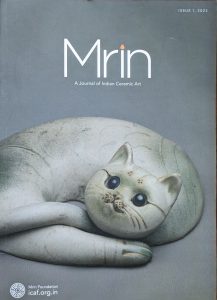 Kristine Michael: The thing is that always, ceramics has been stuck with its nomenclature being functional and art as being non-functional. Even though ceramics is a thing of great beauty and if art is all about beauty, ceramic should have been accepted in the fine arts. However, we’ve also inherited this very colonial attitude about art and craft which over the last 200-300 years has instilled in us this whole thing of craft being a lesser art, even though it is also a thing of beauty. So in the post-independence world, I think that this whole aspect of being tied down by function, and that function cannot be fine art is something that is only now starting to, sort of dissipate, but it’s taken as I mean, Shampa said It has taken a very long time. It was only about 30 years ago that the National Academy is like the Lalit Kala or else the Triennale included ceramics and PR The Rose was one of the first artists who was who was taken in and his work was taken in. So I think ceramic artists have got two things that they’re completely passionate about; One is of course the medium, because it is a very long technical sort of apprenticeship with the material. To be able to understand the material and to have the material get you the effect that you want, it’s not easy. So it tends to be a very long apprenticeship to understand it and the glazing and how it works, the firings etc. So I mean that is the first thing. Then I think the second thing is that in sculpture, when you take sculptures, ceramics is always a waste material. It is always the first thing that the sculpture is made of and then it’s thrown off, you make the plaster mold and then the clay gets thrown off. So it was always considered waste material and for bronze sculptors, it is a waste material. So that’s what’s come through in the art schools. As ‘terracotta doesn’t matter, it’s just waste, it’ll just be thrown off’ and that is also infiltrated down to the art market. It’s very difficult to sort of command the same sort of prices as you would for painting or sculpture or an installation because they say it’s fragile. However, painting is also just on cloth, and cloth can tear.
Kristine Michael: The thing is that always, ceramics has been stuck with its nomenclature being functional and art as being non-functional. Even though ceramics is a thing of great beauty and if art is all about beauty, ceramic should have been accepted in the fine arts. However, we’ve also inherited this very colonial attitude about art and craft which over the last 200-300 years has instilled in us this whole thing of craft being a lesser art, even though it is also a thing of beauty. So in the post-independence world, I think that this whole aspect of being tied down by function, and that function cannot be fine art is something that is only now starting to, sort of dissipate, but it’s taken as I mean, Shampa said It has taken a very long time. It was only about 30 years ago that the National Academy is like the Lalit Kala or else the Triennale included ceramics and PR The Rose was one of the first artists who was who was taken in and his work was taken in. So I think ceramic artists have got two things that they’re completely passionate about; One is of course the medium, because it is a very long technical sort of apprenticeship with the material. To be able to understand the material and to have the material get you the effect that you want, it’s not easy. So it tends to be a very long apprenticeship to understand it and the glazing and how it works, the firings etc. So I mean that is the first thing. Then I think the second thing is that in sculpture, when you take sculptures, ceramics is always a waste material. It is always the first thing that the sculpture is made of and then it’s thrown off, you make the plaster mold and then the clay gets thrown off. So it was always considered waste material and for bronze sculptors, it is a waste material. So that’s what’s come through in the art schools. As ‘terracotta doesn’t matter, it’s just waste, it’ll just be thrown off’ and that is also infiltrated down to the art market. It’s very difficult to sort of command the same sort of prices as you would for painting or sculpture or an installation because they say it’s fragile. However, painting is also just on cloth, and cloth can tear.
The art market has also has taken a long time because you find even now with some recent shows that I have sort of curated when we tried to up the range, people say, “Really that much! So many zeros for ceramics !” so there is still that question mark. I wouldn’t say that countries like sort of Korea, Japan have this problem, they don’t have this problem because they treat the material very differently and it’s sort of revered. And the people who have traditionally worked in clay have also been called national treasures and, really given great honour in recognition but somehow in India that hasn’t happened as yet.
Khanjan Dalal: There’s scepticism about the material itself amongst people, collectors or buyers or people who want to have it because it is a fragile material. Let’s consider that it’s like agar aap patkoge to tut jayega. But then it’s probably a misconception or the kind of the way history has led. The perception is so one sided about these things is that say if when people ask me that it will break, so why should I pay so much which will break ? So I always say that, you go to any museum not in India, even in the entire world, you go to any big museum you look at the collection from historical collection and see what is there. Show me any painting from Mesopotamia or that sort of a place. How have we discovered civilizations and the kind of life that people lived in those 5000-7000 years ago? It’s through the ceramics that they used to use and that those ceramics are still there, they’ve survived.
Nidheesh Tyagi: They outlasted civilisation.
More the fragment, the more precious it has become eventually. Therefore I think it is one thing that needs to be understood that a fire clay is going to last you more than any of these 10-12 generation. Even if it breaks down it can be fixed back, it can be worked, and it still looks beautiful and still looks perfectly fine. Let’s get this idea out of the collectors mind, that no, it is as important medium and it is as good and it is as relevant and valuable as any other medium, like painting or bronze or whatever that you see, that needs to change. I think the galleries and museums have now started working towards that. More and more galleries are now I see that they want to at least showcase one or two shows or they want to represent one or two ceramicist. There is like baby steps, but also we need to change all these mind-sets, all these problems that we are facing at this moment and things will move. I think things are moving in better direction. What do you think?
Nidheesh Tyagi: I think there are clearly three things which come out of what you are saying. One is at the education level itself there is a kind of short changing at the market level, again we see this change as Kristine was saying that, how its still being seen as craft and waste. Not so positive adjectives associated with ceramics. I want to return to this edition of Mrin and Shampa can you just talk about the edition and what all it has and why this is such a special, in a way tribute to this wonderful work of art you all do.
Shampa Shah: As Daroz said at the launch of the first issue that he had waited 50 years for this. When he said that I truly thought of Jyotsna Bhatt and all those people. Today when we are discussing Christine, I and you, we are still talking about this situation and what ceramics is facing. Think of all those pioneers when they were doing it. I was really tired when he said that. , I’ve really waited for 50 years for this magazine which is fully dedicated to ceramics. This first issue, of course have to focus on certain pioneers because we had lost Jyotsna Bhatt. So, the cat on the cover is her work, and then the issue opens with an article by Ira Choudhary on her work. I mean it, its reminiscence. She’s 97 and she can remember the first day she saw Jyotsna Bhatt walking into the college to get admission at Baroda Art College. She recalls that day and what she had brought for the entrance exam, and from there she connects those things with her work. Then we have section where conversation happens. The conversation is with PR Daroz who incidentally happens to be my as well as Dipali’s teacher. So I myself and Dipali have done the conversation with him. It’s a long one and tries to encapsulate his, question around his entire body of work. As Christine was saying, this is a medium which has so much to do with technique and we have been grappling with it. Daroz has also been a pioneer in making the kind of gas furnaces which now each of us is using. He was probably the first one to introduce the gaskin which is way cheaper and affordable and can be fixed in any house. Then there are all these articles, one written by Raja Mohanty. He teaches at Bombay IIT and he has been dealing with students who are overburdened with stress. They have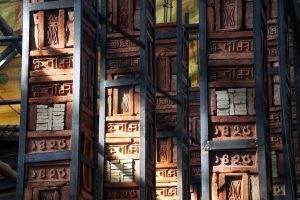 nothing to do with ceramics. But Bombay IIT has a class for ceramics, and he’s saying there’s a queue, there’s a big-big queue to enter into this class. All the students feel the kind of distressing and the way they can feel involved and the way the time slows down for them is very beautifully expressed there in that article. There’s one chapter which would be dedicated to a technique and in the first issue that is by Shashank Nimkar. In that article he’s saying that it’s immortal, it will not perish do whatever. So industrial ceramic waste is also a concern for all of us and Shashank Nimkar has dealt with it, how and what to do with that industrial ceramic waste. He has developed a very interesting way of recycling all that ceramic waste, so that it can be reused without losing its quality. It will lose its plasticity but it can still be worked on. Then in Kolkata, there’s this amazing thing of Durga puja pandals and Partha Das Gupta has been creating huge pandals. It’s just for four days, he creates this huge pandal with how many bricks and he structures them as kills and fires them there. Large part of that actually fired on the ground and can you believe this that it will be dismantled in four-five days. But this is what he’s talking about in this article titled ‘Brick by Brick’. He’s talking about, how these bricks are now part of history and they will go back to different parts of the country maybe and reused and re-enter a different space. So these are some of the articles. There are others but maybe Kristine should talk about them.
nothing to do with ceramics. But Bombay IIT has a class for ceramics, and he’s saying there’s a queue, there’s a big-big queue to enter into this class. All the students feel the kind of distressing and the way they can feel involved and the way the time slows down for them is very beautifully expressed there in that article. There’s one chapter which would be dedicated to a technique and in the first issue that is by Shashank Nimkar. In that article he’s saying that it’s immortal, it will not perish do whatever. So industrial ceramic waste is also a concern for all of us and Shashank Nimkar has dealt with it, how and what to do with that industrial ceramic waste. He has developed a very interesting way of recycling all that ceramic waste, so that it can be reused without losing its quality. It will lose its plasticity but it can still be worked on. Then in Kolkata, there’s this amazing thing of Durga puja pandals and Partha Das Gupta has been creating huge pandals. It’s just for four days, he creates this huge pandal with how many bricks and he structures them as kills and fires them there. Large part of that actually fired on the ground and can you believe this that it will be dismantled in four-five days. But this is what he’s talking about in this article titled ‘Brick by Brick’. He’s talking about, how these bricks are now part of history and they will go back to different parts of the country maybe and reused and re-enter a different space. So these are some of the articles. There are others but maybe Kristine should talk about them.
Nidheesh Tyagi: Kristine will talk about the next edition as she’s going to edit it. I love this idea of revolving editors policy, it gives a new flavour in a way, it remains collective as well as it has a kind of individual stamp to what we do.
Khanjan Dalal: No, I think it is important to do that because we have taken it as a policy decision to rotate among us. First, I think the most practical reason is that now Shampaji has enough time to think about the third one. And in meantime, Kristine will work out the second one and then the forth one. So it’s going to be like a jugalbandi between them. So it’s going to be a lot of fun and I think the readers are going to enjoy that whole aspect a lot because both bring interesting stuff, both have the capacity to really observe things and put them into an edition in the most concise way. So that’s going to be fun. Therefore we do not have a one person who’s editing the entire thing, but it’ll be rotating between them.
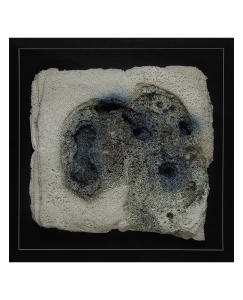
Courtesy- Gallerie Nvya
Kristine Michael: The second edition will basically follow the same deals and the structure that has been given by Shampa. So it will be something about networking for sure. It will be opportunities for artists, younger artists. It will be recapping what has happened in the past six months over the country. Treating it as a growing awareness because a lot of the younger potters who have come don’t know anything about the history of studio pottery here in India. So this entire chapter about legacy, about a conversation between somebody who is visiting an older artist studio, looking at their work, reporting about it would be something of a great deal of interest. Otherwise you have lost your history and as Shampa said, there are very few writers within the artist community and we would like to tap on them and, most of them are hesitant. So it’s just a question of editing. So if they write, if one encourages them to write, then they’re also expanding their own skills because I found this being a sort of curator it’s really difficult to get them to write their artistic comments or to get them to talk about why are you making the work that you’re making, what is the link? How is it in your entire mind frame or artistic frame? So this is a way of growing skills within the community. And I think that’s very important because you give people the opportunity to write. Normally we don’t have an opportunity to write. You just do your own artist statement but no big magazine like Art India Magazine or Art and Deal or Take on Art etc will ask a ceramic person to write. If you haven’t had any experience to write. So even if you want to the chances are not there. So this is a chance to write, to express yourself and I think that’s important. The various aspects of ceramics that it’s used for play, it’s used for education, used as therapy, used in public spaces and architecture. All these are different aspects of that same material. So we don’t want it to only be about the fine art. Yes, there will be definitely stuff about technique. Maybe somebody who has mastered a particular technique and Khanjan and I were talking about soda firing the other day and talking about Rakhi and what a wonderful show she has just done and she has really mastered that entire style and technique. So would she be willing to share her technique and explain about how she gets her wonderful surfaces. That’s always something of a great deal of interest. So, the magazine deals on different levels. We hope we’ll have something for everyone, something educational, something technical, something on the shows on senior artists, artists who aren’t with us anymore, maybe book reviews, maybe film reviews; films sort of related with clay and ceramic. So that’s the way it’s going right now.
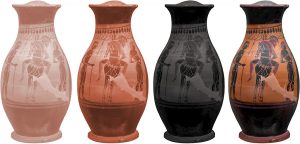
Shampa Shah: In the magazine is also going to be on the One section of the magazine is on the ‘Dairies of the Artist’. So you actually understand the entire process of an artist, how a form gets formed. You get a peep into the actual process of the making of a form. I thought that was very interesting. And in the first issue we have three very different sets of diaries by Madhavi Subramanyam and other by Mudita Bhandari and the third by Savia Mahajan. They approach it in a very different way, so I thought that was very exciting. The one section what Kristine was also mentioning, one ceramic artist visiting another ceramic artist and probably spending a day at the studio and writing about that studio.
Nidheesh Tyagi: I was with Kristine the other day looking at a curated show around glassworks and that day she was talking about how this is such a collaborative thing, because one, it is a continuous thing, there is a kind of a business continuity to ceramics, it can’t just be one person who is doing it and then it gets over with him or her. So one other thing is that probably, making it collaborative how to ensure the continuity of it because if you don’t, if there’s nothing documented or recorded somewhere, then the threads are lost. And if it’s not collaborative, then how does it like cross pollinate, how does it multiply and how does it become a bigger universe.
Kristine Michael: Yeah. And of course one thing that is of interest to all of us is looking at the traditional artisanal craft base. So we have the article right now on the black pottery. And there’s been a lot of work in this area been done by various sort of design communities so my particular interest is in looking at that sort of design development and product development within the tradition. I think that’s something that I would like to also bring in because all of us work a lot with the local craftspeople, with the local potters. In fact you’ll find that all of the senior potters have all learned from a local potter. Puna bhai from MS University, Baroda, NID had its own guy and I’m sure BHU also had even Gurcharan Singh has always mentioned that he learned this art of blue or blue glazing from a pathan potter. So that link should not be lost because it is an inclusive magazine that’s very important and I would also like to see it some point in time. We have some translated bits, some in Hindi and some in English, so we have a wider scope to go sort of beyond the English speaking, slightly privileged, entitled, community of artists. So it goes a little beyond and can be read and can be accessed by a whole range of people. So that’s things to aspire to, but right now it’s early days, so let’s at least get out the English version and later we can look at translating in Hindi.
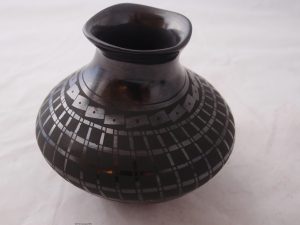
Courtesy- Spirits in the wind gallery
Nidheesh Tyagi: It’s all mostly about India, but are you thinking also about bringing what is happening in the world towards the magazine and in these conversations?
Kristine Michael: We have a lot of connections with international exhibitions or artists and various things like that. But yes, definitely that is something to look at, the need of the hour is for us to really network as of Indian community. Through this I hope that we’ll be able to find an Indian identity to the ceramic art. Some of the work is very derivative. But when you look at an Indian ceramic artist, what is it about them that shout out that this is an Indian sensibility. Do we have that as yet? And I think that’s where we need to go, to go towards as a community. And I’m hoping that the magazine will be able to raise issues like this.
Nidheesh Tyagi: What should be the advice you will be giving to young artists because as Abir we are part of conversations happening around young artists community and some of them are interested in ceramics and some of them will get interested by the time when they listen to you, when they read the magazine. So what is the advice you would be giving to somebody who wants to or somebody who’s already started practicing into ceramics?
Kristine Michael: I would say meet, network, absorb from everybody because you’ll find that the ceramic world is very generous. It’s very inclusive, very inclusive, very generous, very willing to share, and we all love a great party. Everything here is a great party. So just be there, visit. Don’t be closed.
Khanjan Dalal: I consider myself as young practitioner into this. A very important factor is that, people who practice ceramics are very open. I was trained as a painter, so I worked as a painter and an installation artist. Sharing ideas, sharing knowledge, sharing technicalities was a big problem. Everybody just kept things to themselves all the time. In ceramics. It’s not like that. In ceramics, everybody shares everything very openly most of the time. Even ICAF is about sharing. More than anything it’s about sharing. So we’re going to do this and I think just look out for us in terms of your problems, your questions or aspiring ceramicist who are looking for answers, solutions and things like that. There will be more, information, knowledge and this is the platform that we are looking at.
Nidheesh Tyagi: It’s a very physical thing to do because, even if I have to learn, I would like to come physically.
Khanjan Dalal: Exactly. It is not an image based practice, it’s an hands on practice. Therefore I think it’s very important that the knowledge is open and the willingness to share knowledge is also there. People will benefit in the future from so many platforms like this.
Nidheesh Tyagi: Is there a structure where you offer your mentoring service that I’m happy to be a mentor if people want to come and approach you, how does that happen?
Khanjan Dalal: All the time. There are people taking classes. Right now there is a workshop going on in GBP where they’ve called two American artists who are going to fire their anagama style kiln. Besides institutions, these workshops and these classes and tutorials are always going on. Senior people are always organizing these kind of things for younger people to join. Probably the younger people should be looking out for these kind of things all the time, through groups and by talking to other people and talking to their mentors.
Nidheesh Tyagi: Do you have a online place like Facebook or somewhere where people get to know about it?
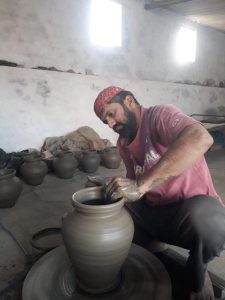
Khanjan Dalal: Not at the moment but yes we will be having that sort of a thing where there is going to be a listing of things, listings of workshops that are going to happen in the next one year, listings of exhibitions that are going to happen in the next one year. That whole listing section is going to be part of the next issue as well. So everybody will get that information that about what all they can join. Also recently there is a group which was formed known as ‘The organizers of the potters market’. We have potters market happening in different cities at this moment. So they’re like right now there are about 10-12 potters market happening in India. Sonia Rashid has taken initiative and created the group. Earlier it was very informal way where we didn’t know about whose dates are happening and who’s doing. So now this group is formed to channelize those dates. Now you will see a whole program for one year, which potters market is happening when and where. So this sort of information is going to get very channelized and published way in advance for the benefit of practicing artists as well as students as well as supporters of the medium.
Nidheesh Tyagi: Any more suggestion from Kristine ?
Kristine Michael: In one way the growth of ceramics has been really tremendous with its sort of therapeutic side to it. Lots of corporates are using it as a way of distressing. It has become the hobby thing for the corporate world also. But one has to make a definition between the serious ceramic artist and the hobby artist. It can go down the kitty party way and quite often it does. So it’s a little bit of a sensitive area as to who is that artist who has made that sort of leap from being a hobbyist into then the potters market, then into the gallery; can one do that or do you need to have that art school training in order to reach the gallery? So all those things are still sort of negotiable and I know that that’s a bit of a grey area. As to what is the sort of work that you need to be able to be in a gallery, to be in an art fair, to be in the in the Indian art fair, that’s a completely different level. To be completely really dependent on your ceramic to live off it, to pay your bills from it that’s a completely different ball game. The people who are at the art fair level are very willing to share their expertise and their knowledge of the art market. But not every gallery will accept every hobby potter into their gallery space and that’s why there’s a bit of grey area. Because What defines the quality of that work, Is it the conceptual quantity? Is it the technical skill? So that’s something that needs to be discussed further within the community. As a curator I have people asking me questions like this. “What do I need to do to be able to get into a certain gallery, to be able to get into an art fair?” So I do advise to a certain extent, but then. it’s not always possible because it’s that person’s journey. It’s that artistic line. There are no defining lines. So we’re hoping that a magazine like this will cater to everybody. The artist who’s at the art fair, as well as the student as well as the hobby potter.
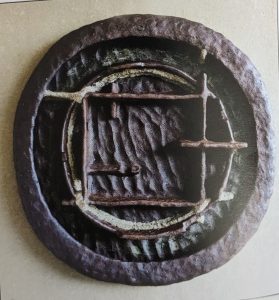
Shampa Shah: Well, I think what Christine pointed out, I think we ceramists do need to remember that, clay is only a medium, so we can’t be talking of the technique all the time. How does it matter if the sculpture is in clay or in any other medium! The clay is only a medium. Medium of course is very important and yet my work doesn’t get completely dictated by the medium. So the entire thought process or the form I’m working upon is probably the key to it and we as ceramic artist have to really need to focus on form and what is our inner journey as an artist, has to get expressed in clay. Whether it uses a very primitive technique or a very advanced technique in ceramics, it’s immaterial. Ultimately, it’s the work which has to speak out. So we need to shift our focus. Technique is important, but it’s part of learning. Technique will not guide your work, it will not make your work, it will not give it it’s worth. What is going to define your work is the kind of relationship as an artist you have with the medium, with form, with the entire world.
Nidheesh Tyagi: How does the market become more aware about the great things happening in ceramic art in India?
Shampa Shah: One thing is that we are hoping that this magazine will play a very important role in it. That’s why, as you were saying, why the need for a separate magazine? I think because this medium wasn’t getting its due. Also the other side of it, the ceramic artist really need to question themselves. Why have they chosen clay? What does this material mean to them? There has to be a serious engagement with the medium. There has to be a more serious engagement with yourself. And once I think you have those answers, things will workout in themselves. That’s what I feel.
Nidheesh Tyagi: How do we deal with the market?
Khanjan Dalal: In the same way that the way we deal with the market with other mediums. It has to be firstly accepted in the same way we accept other things. It’s no different but at the same time, it is always perceived as the functional material. Therefore there is a kind of an idea of something being less. Woh mitti hi hai na.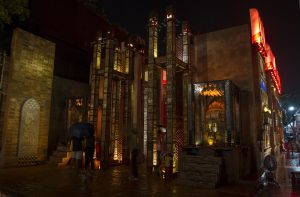
Nidheesh Tyagi: It’s kind of a derogatory statement
Yeah, but it’s completely the opposite if you go to Japan or Korea, they value their simplest cup to probably ₹3,00,000. I’ve seen that stuff, then you realize that this is the value that they are putting. How do you value something? How do you value your cultural production? I think we need to know how to value it. And once you understand that, it’s not about ki who mitti hai but it’s about what has the person done with that and how do you value that and what is the cultural significance of that? is what important. It is as equal as to somebody doing a painting or somebody working in any other medium. We need to work towards that, we need to open up the market opportunities for people. For instance even in West we never saw mainstream galleries showing works by ceramic artists. Lately Gagosian is showing Theaster Gates now or Hauser and Wirth is showing ‘Sterling Ruby’. So, that sort of thing never happened. The only person in the entire world who’s had a retrospective else ceramics in MoMA is Betty Woodman. Why? Does that mean that the people who work in that are lesser of the people who work in the other mediums? No, the perception is different and the perception now needs to change. It has been changing and and we’ll see the change also. So I think what we are actually witnessing now is the history now it’s becoming part of the mainstream and therefore it’s more consumable, more and more people will appreciate it, more and more people will value it. First you value it.
Nidheesh Tyagi: With MRIN I think there will be clearly more spotlight, which will be a great thing in the future. We thank you for participating in this discussion but we also thank MRIN editorial team because they have been very kind to let us use some of their articles for our website and we would be very keenly collaborating with them in future to be part of this initiative how to make this universal ceramics slightly bigger and how to expand and enhance the conversations around ceramics. Thank you so much.

